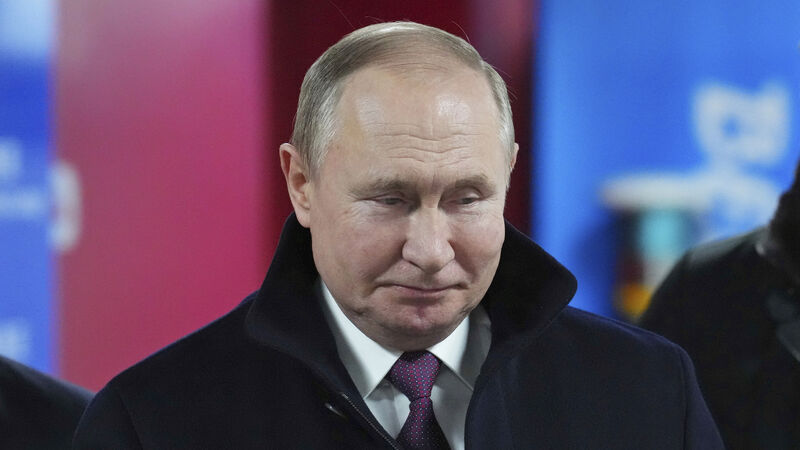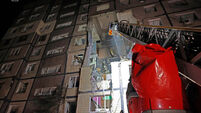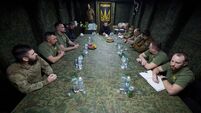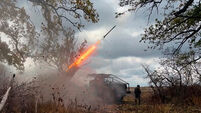Dorcha Lee: Will Vladimir Putin opt for Russian tanks or French diplomacy?

Russian President Vladimir Putin likes to play mind games with his adversaries. Photo: Carl Court via AP
Russia’s president, Vladimir Putin, likes to play mind games with his adversaries, to get them off guard and disrupt their concentration.
He did it at his meeting in Moscow, in July 2017, with German chancellor Angela Merkel, by bringing his black Labrador dog, Koni, into the room. Ms Merkel has had a deep fear of dogs since childhood and was quite tense and distracted throughout the meeting.
The Russian public loved it. The media had their story, and nobody remembers what the meeting was all about. And now Putin has gone and done it again. This time in stage-managing his meeting with French president Emmanuel Macron on the crisis in Ukraine.
Before the meeting, Mr Putin invited Mr Macron to take a Russian test for Covid. Mr Macron declined and was then led into this conference room with the crazy long table. The shots of two relatively small men sitting so far apart at opposite ends of an elongated table looked weird.
Moreover, the cameraman was much closer to Mr Putin, who looked calm, relaxed, normal-sized. When the camera panned to Mr Macron, he seemed ridiculously far away and small, like a child who had been banished to the end of the table for not taking his medicine.
Nevertheless, Mr Macron is the right man in the right place and could make a real difference. What the media have largely not commented on is that France holds the presidency of the EU. The last time they had the presidency, there was a 10-day war between Russia and Georgia in August 2008.
Mr Macron’s predecessor as president, Nicolas Sarkozy, successfully negotiated a ceasefire and a withdrawal of all forces back to their boundary lines. The French are best placed to repeat that role.
As it was, Mr Macron had a five-and-a-half-hour meeting with Mr Putin. Reports indicate that progress was made, and a consensus has emerged that stakeholders might return to the negotiations and seek a resolution through the Minsk Agreement.
The diplomatic pathway for this can remain open, even through the coming conflict, should it take place.
In assessing the Russian build-up, everyone can be a defence analyst. The quite high resolution of commercial satellite photography is easy to read on Google. The Russian forces assembly areas are located close to the main likely axes of advance and no attempt is made to camouflage the main units.
The current Russian build-up shows they have the capacity to invade Ukraine along nine different access routes. It remains to be seen which routes of advance are primary and which are just diversionary.
The first consideration is the paramount importance of the Dnieper River, a major obstacle to land movement, so broad, in fact, that it resembles a chain of lakes. There are very few bridges, mostly at key towns. The river divides west Ukraine from east.
There are two important objectives in the Crimea area. The Russians will try to open up a land link from Russia to Crimea, heading west from Rostov-on-Don, capturing the port of Mariupol and on to Melitopol, where they could link up with units from Crimea.
Then an attack northward out of Crimea to the Khersen area, to secure the western end of the North Crimean Canal. This was blocked by the Ukrainians in 2014, in retaliation for the Russian intervention in the Donbas region and the annexing of Crimea.
This attack would be preceded by Spetsnaz (Russian special forces) attacks to seize Khersen. This canal carried water from the Dnieper River and is used to supply from 85% up to 90% of Crimea. Crimea has resorted to deep-well drilling and desalinisation. To the west of Crimea, there is a possibility of a seaborne attack on Odessa and a land invasion north to Transdniestria.
The main Russian attacks from eastern Ukraine would move rapidly to the Dnieper capturing the bridges in the three river towns of Kremenchuk, Dnipro, and Zaporizhzhia. It would be more likely that the advance from Belgorod would bypass Ukraine’s second-largest city, Kharkiv.
If Mr Putin plans to overthrow the regime, he could launch a pincer movement from Kursk in western Russia direct to Kyiv and with Russian and Belarusian forces heading south from Mazyr in Belarus to Kyiv.
If the Russian advance is fast enough and uses Spetsnaz to capture the Dnieper bridges, the Russians could capture half the Ukrainian army on the east side of the Dnieper. If Mr Putin leaves western Ukraine alone, he should achieve his other objectives in a week, and return to a revitalised Minsk agreement in a stronger position.
- Colonel Dorcha Lee (retired) is a defence analyst
















